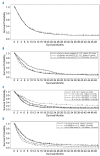International reference analysis of outcomes in adults with B-precursor Ph-negative relapsed/refractory acute lymphoblastic leukemia
- PMID: 27587380
- PMCID: PMC5479605
- DOI: 10.3324/haematol.2016.144311
International reference analysis of outcomes in adults with B-precursor Ph-negative relapsed/refractory acute lymphoblastic leukemia
Abstract
Adults with relapsed/refractory acute lymphoblastic leukemia have an unfavourable prognosis, which is influenced by disease and patient characteristics. To further evaluate these characteristics, a retrospective analysis of 1,706 adult patients with Ph-negative relapsed/refractory B-precursor acute lymphoblastic leukemia diagnosed between 1990-2013 was conducted using data reflecting the standard of care from 11 study groups and large centers in Europe and the United States. Outcomes included complete remission, overall survival, and realization of stem cell transplantation after salvage treatment. The overall complete remission rate after first salvage was 40%, ranging from 35%-41% across disease status categories (primary refractory, relapsed with or without prior transplant), and was lower after second (21%) and third or greater (11%) salvage. The overall complete remission rate was higher for patients diagnosed from 2005 onward (45%, 95% CI: 39%-50%). One- and three-year survival rates after first, second, and third or greater salvage were 26% and 11%, 18% and 6%, and 15% and 4%, respectively, and rates were 2%-5% higher among patients diagnosed from 2005. Prognostic factors included younger age, longer duration of first remission, and lower white blood cell counts at primary diagnosis. This large dataset can provide detailed reference outcomes for patients with relapsed/refractory Ph-negative B-precursor acute lymphoblastic leukemia. clinicaltrials.gov identifier: 02003612.
Trial registration: ClinicalTrials.gov NCT02003612.
Copyright© Ferrata Storti Foundation.
Figures




Comment in
-
Historical Controls?Haematologica. 2017 Mar;102(3):e117. doi: 10.3324/haematol.2016.159707. Epub 2017 Feb 28. Haematologica. 2017. PMID: 28250008 Free PMC article. No abstract available.
Similar articles
-
How I treat adults with relapsed or refractory Philadelphia chromosome-negative acute lymphoblastic leukemia.Blood. 2015 Jul 30;126(5):589-96. doi: 10.1182/blood-2014-09-551937. Epub 2015 May 12. Blood. 2015. PMID: 25966988
-
Blinatumomab versus chemotherapy in first salvage or in later salvage for B-cell precursor acute lymphoblastic leukemia.Leuk Lymphoma. 2019 Sep;60(9):2214-2222. doi: 10.1080/10428194.2019.1576872. Epub 2019 Apr 5. Leuk Lymphoma. 2019. PMID: 30947585 Clinical Trial.
-
Blinatumomab in pediatric patients with relapsed/refractory B-cell precursor acute lymphoblastic leukemia.Eur J Haematol. 2021 Apr;106(4):473-483. doi: 10.1111/ejh.13569. Epub 2021 Jan 11. Eur J Haematol. 2021. PMID: 33320384
-
Blinatumomab: Bridging the Gap in Adult Relapsed/Refractory B-Cell Acute Lymphoblastic Leukemia.Clin Lymphoma Myeloma Leuk. 2016 Aug;16 Suppl:S2-5. doi: 10.1016/j.clml.2016.02.001. Clin Lymphoma Myeloma Leuk. 2016. PMID: 27521320 Review.
-
Blinatumomab for the Treatment of Philadelphia Chromosome-Negative, Precursor B-cell Acute Lymphoblastic Leukemia.Clin Cancer Res. 2015 Oct 1;21(19):4262-9. doi: 10.1158/1078-0432.CCR-15-0125. Epub 2015 Aug 17. Clin Cancer Res. 2015. PMID: 26283683 Review.
Cited by
-
Recent advances on blinatumomab for acute lymphoblastic leukemia.Exp Hematol Oncol. 2019 Nov 6;8:28. doi: 10.1186/s40164-019-0152-y. eCollection 2019. Exp Hematol Oncol. 2019. PMID: 31709129 Free PMC article. Review.
-
Safety of AFM11 in the treatment of patients with B-cell malignancies: findings from two phase 1 studies.Trials. 2023 Jan 3;24(1):4. doi: 10.1186/s13063-022-06982-7. Trials. 2023. PMID: 36597128 Free PMC article. Clinical Trial.
-
BH3 mimetics in relapsed and refractory adult acute lymphoblastic leukemia: a Campus ALL real-life study.Haematologica. 2024 Mar 1;109(3):988-993. doi: 10.3324/haematol.2023.283684. Haematologica. 2024. PMID: 37794811 Free PMC article. No abstract available.
-
Blinatumomab consolidation and maintenance therapy in adults with relapsed/refractory B-precursor acute lymphoblastic leukemia.Blood Adv. 2020 Apr 14;4(7):1518-1525. doi: 10.1182/bloodadvances.2019000874. Blood Adv. 2020. PMID: 32289160 Free PMC article.
-
Adult Low-Hypodiploid Acute Lymphoblastic Leukemia Emerges from Preleukemic TP53-Mutant Clonal Hematopoiesis.Blood Cancer Discov. 2023 Mar 1;4(2):134-149. doi: 10.1158/2643-3230.BCD-22-0154. Blood Cancer Discov. 2023. PMID: 36630200 Free PMC article.
References
-
- Bassan R, Hoelzer D. Modern therapy of acute lymphoblastic leukemia. J Clin Oncol. 2011;29(5):532–543. - PubMed
-
- Fielding AK, Richards SM, Chopra R, et al. Outcome of 609 adults after relapse of acute lymphoblastic leukemia (ALL); an MRC UKALL12/ECOG 2993 study. Blood. 2007;109(3):944–950. - PubMed
-
- Gokbuget N, Stanze D, Beck J, et al. Outcome of relapsed adult lymphoblastic leukemia depends on response to salvage chemotherapy, prognostic factors, and performance of stem cell transplantation. Blood. 2012;120(10):2032–2041. - PubMed
Publication types
MeSH terms
Associated data
Grants and funding
LinkOut - more resources
Full Text Sources
Other Literature Sources

